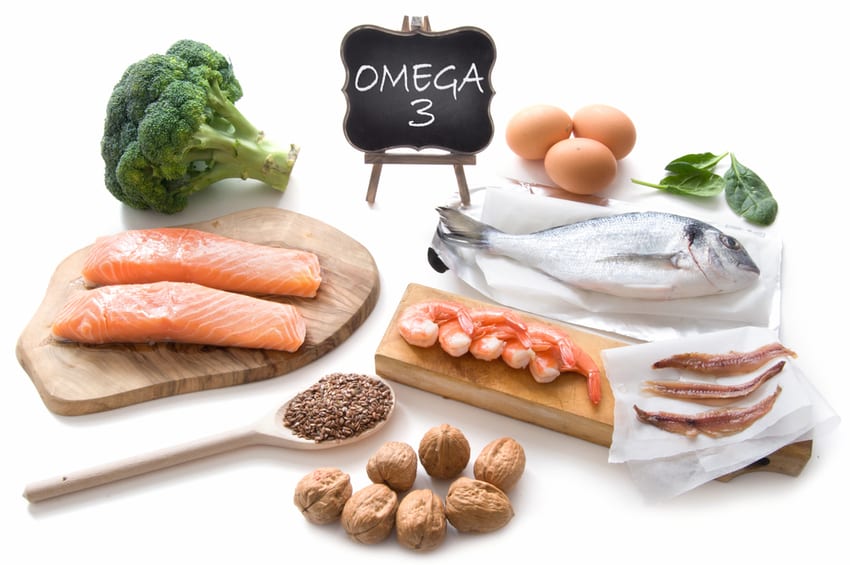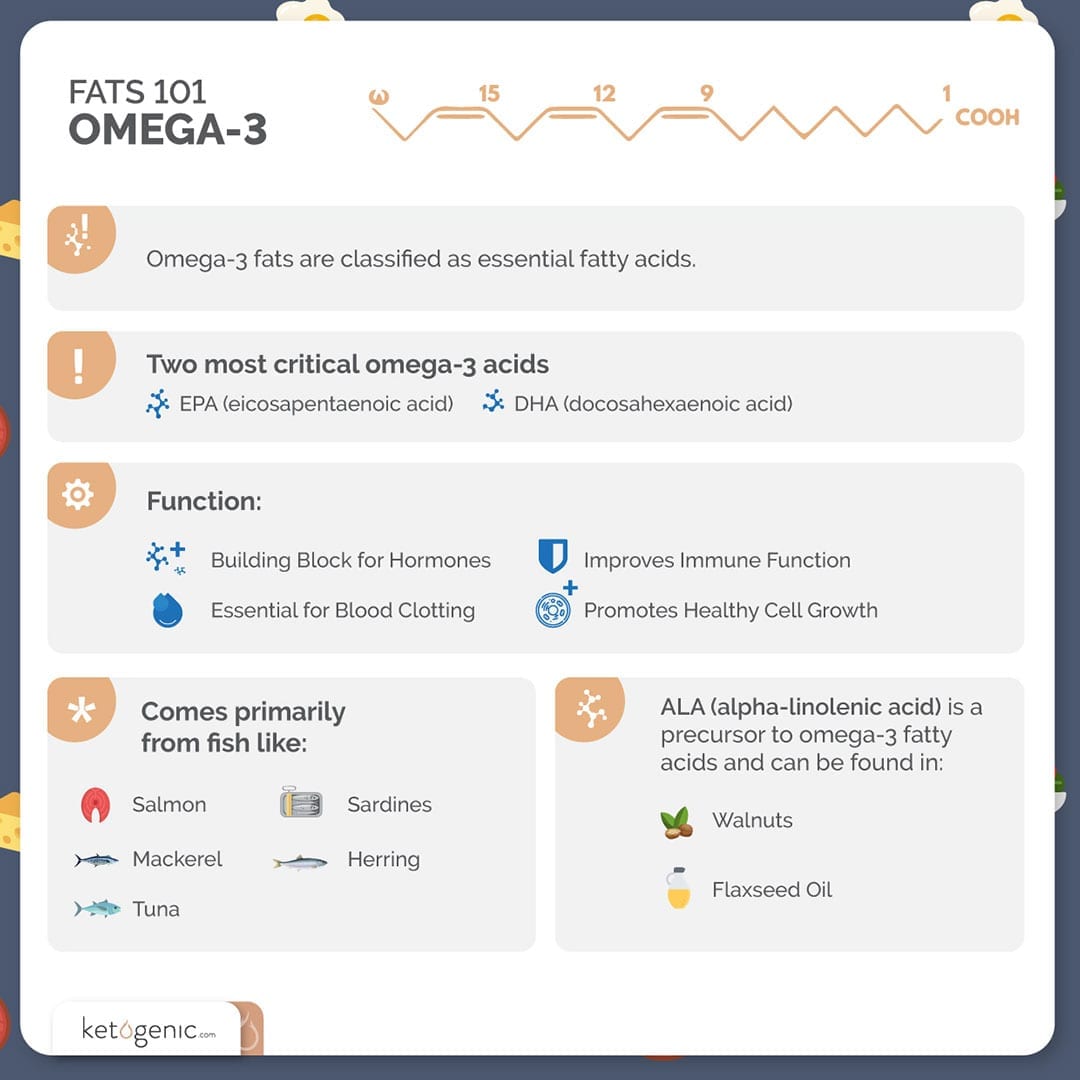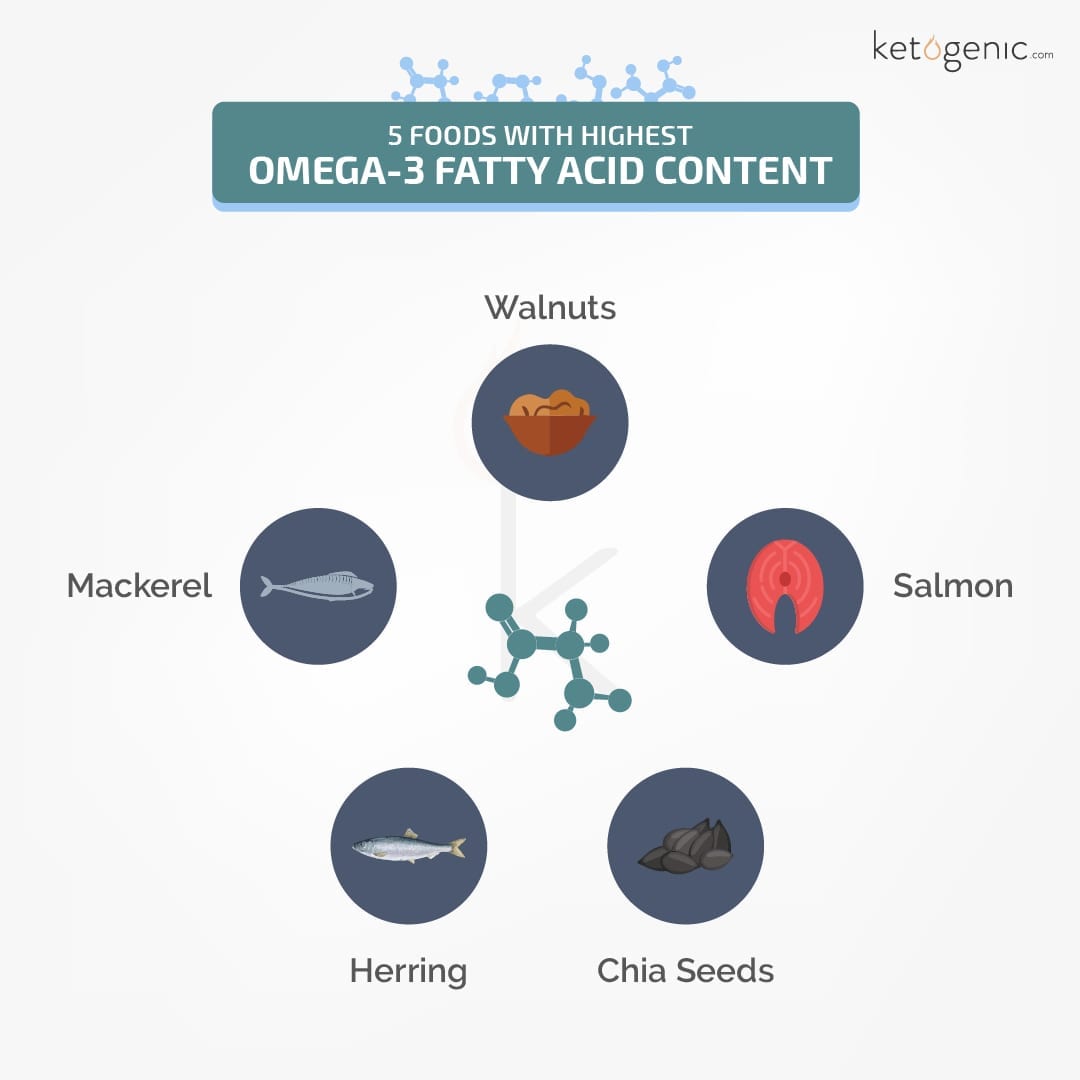
Everyone has heard of omega-3s and how they’re beneficial for health. These omega 3 fatty acids can be found in various nutritious foods. Some mainstream health organizations recommend healthy adults get a minimum of 250-500mg of omega-3s daily! [1] [2] [3].
Optimize your ketogenic diet by adding in more omega-3s! Here are some of the top keto-friendly foods high in omega 3 fatty acids:
1. Mackerel
Mackerel are delicious, small, fatty fish that require little preparation. Mackerel are usually smoked and consumed as whole fillets. Nutrient-rich, one 3.5 ounce serving provides 200% of the RDI (reference daily intake) for vitamin B12 and 100% for selenium. When it comes to omega-3 content, you’ll find 4,107mg in one piece of salted mackerel or 5,134mg per 3.5 ounces (100 grams) [4].
2. Salmon
Salmon is often touted as a nutrient-dense superfood with good reason. Salmon has high-quality protein and various nutrients, including high amounts of selenium, B vitamins, and vitamin D. It’s also important to note that wild-caught salmon might contain more nutrients than farmed salmon [5] [6].
Studies show those who frequently eat fatty fish like salmon have a lower risk of diseases like dementia, depression, and heart disease. [7] [8] [9] [10]. The omega-3 content of salmon is impressive, with 4,123mg in half a fillet of cooked, farmed Atlantic salmon, or 2,260mg in 3.5 ounces (100 grams).
3. Herring
Herring is often pickled, precooked, or cold-smoked, and sold as a canned snack. This medium-sized oily fish is a popular breakfast food in places like England, where it’s served with eggs and called kippers. One standard smoked fillet has nearly 100% of the RDI for selenium and vitamin D and 221% of the RDI for vitamin B12. Herring is high in omega-3s with 946mg per medium fillet (40 grams) of kippered Atlantic herring, or 2,366mg per 3.5 ounces (100 grams) [11].
4. Oysters
You’ve probably heard that shellfish are some of the most nutritious foods you can eat. Oysters actually contain more zinc than any food on the planet. 6 raw eastern oysters (85 grams or 3 ounces) packs 293% of the RDI for zinc, 575% for vitamin B12, and 70% for copper [12] [13].
You can eat oysters as a snack, a whole meal, or an appetizer. In many countries, raw oysters are considered a delicacy. You can find an impressive 370mg of omega-3 content in 6 raw, eastern oysters, or 435mg per 3.5 ounces (100 grams).
5. Sardines
Sardines are small oily fish commonly consumed as a snack, starter, or delicacy. Sardines are popular among keto travelers or keto dieters on-the-go because they’re convenient, tasty, and packed with healthy fats. Sardines actually contain almost every nutrient your body needs. 100 grams (3.5 ounces) of drained sardines deliver over 200% of the RDI for vitamin B12, 96% for selenium and 24% for vitamin D. One cup (149 grams) of canned Atlantic sardines gives you 2,205mg of omega-3 content, or 1,480mg per 3.5 ounces of sardines (100 grams) [14].
6. Anchovies
Anchovies are often bought canned or dried. These tiny, oily fish are typically eaten in small portions, rolled around capers, used as salad or pizza toppings, or stuffed in olives. Because of their strong and distinctive taste, anchovies are used to flavor various sauces and dishes, including remoulade, Caesar dressing, and Worcestershire sauce.
Anchovies provide niacin and selenium, and boned anchovies are also a decent source of calcium. One can (2 ounces or 45 grams) of European anchovies provides 951mg of omega-3 fatty acids. 3.5 ounces (100 grams) of anchovies provides 2,113 mg of omega-3s [15].
7. Caviar
Caviar refers to roe or fish eggs — a delicacy and luxurious food item often used in small quantities as a taster, garnish, or starter. Caviar provides choline and omega-3 fatty acids. One tablespoon (14.3 grams) of caviar gives you 1,086mg of omega-3 fatty acids. 3.5 ounces (100 grams) of caviar gives you 6,786mg of omega-3s [16].
8. Cod Liver Oil
Cod liver oil refers to the oil extracted from the livers of codfish. Cod liver oil is usually taken as a supplement and it’s loaded with vitamins A and D. One tablespoon provides 453% and 170% of the RDIs. When it comes to omega-3 fatty acids, cod liver oil delivers 2,682mg per tablespoon [17].
9. Plant Sources
The omega-3 fats EPA and DHA are found only in some animal foods, algae, and seafood. ALA is found in plant foods like flax seeds, chia seeds, and walnuts. ALA is considered inferior to the other two. Gram for gram, keep in mind the omega-3 fatty acids in chia seeds aren’t as potent as those found in fish oil or fish (EPA and DHA). Your body needs to convert the ALA found in chia into the active forms (DHA and EPA) before your body can properly utilize it. This process is often inefficient with most people [18] [19] [20].
Flax seeds are little yellow or brown seeds that are usually milled, ground, or made into an oil. They contain nutrients like magnesium and fiber. Of all whole plant foods, flax seeds have the highest alpha-linolenic acid (ALA) content. Flaxseed oil is a popular omega-3 supplement. One tablespoon (10.3 grams) of whole flax seeds provides 2,350mg of omega-3s. One tablespoon (13.6 grams) of oil has 7,260mg of omega-3s. One ounce (28 grams) of chia seeds provides 5,060mg of omega-3s [21] [22] [23] [24].
What are Your Favorite Keto-Friendly Omega 3 Packed Foods?
Comment below and share your favorite foods to get your daily dose of omega 3 in!
References
United States Department of Agriculture & United States Department of Health and Human Services. Dietary Guidelines for Americans 2010. https://health.gov/sites/default/files/2020-01/DietaryGuidelines2010.pdf
World Health Organization. (2008). Interim Summary of Conclusions and Dietary Recommendations on Total Fat & Fatty Acids from the Joint FAO/WHO Expert Consultation on Fats and Fatty Acids in Human Nutrition. 10-14 November, 2008, WHO, Geneva.
EFSA Panel on Dietetic Products, Nutrition, And Allergies (NDA). (2012). Scientific opinion on the tolerable upper intake level of eicosapentaenoic acid (EPA), docosahexaenoic acid (DHA), and docosapentaenoic acid(DPA). EFSA Journal, https://doi.org/10.2903/j.efsa.2012.2815
United States Department of Agriculture. Fish, Mackerel, Salted. https://fdc.nal.usda.gov/fdc-app.html#/food-details/168149/nutrients
United States Department of Agriculture. Fish, Salmon, Atlantic, Farmed, Cooked, Dry Heat. https://fdc.nal.usda.gov/fdc-app.html#/food-details/175168/nutrients
United States Department of Agriculture. Fish, Salmon, Atlantic, Wild, Cooked, Dry Heat. https://fdc.nal.usda.gov/fdc-app.html#/food-details/171998/nutrients
Su, K-P., Huang, S-Y., Chiu, C-C., & Shen, W. W. (2003). Omega-3 fatty acids in major depressive disorder: A preliminary double-blind, placebo-controlled trial. Eur Neuropsychopharmacol, 13(4), DOI: 10.1016/s0924-977x(03)00032-4
Wang, C., Harris, W. S., Chung, M., Lichtenstein, A. H., Balk, E. M., Kupelnick, B., Jordan, H. S., & Lau, J. (2006). n-3 fatty acids from fish or fish oil supplements, but not alpha-linolenic acid, benefit cardiovascular disease outcomes in primary- and secondary-prevention studies: A systematic review. American Journal of Clinical Nutrition, 84(1), 5-17. DOI: 10.1093/ajcn/84.1.5
Barberger-Gateau, P., Letenneur, L., Deschamps, V., Peres, K., Dartigues, J-F., & Renaud, S. (2002). Fish, meat, and risk of dementia: Cohort study. British Medical Journal, 325(7370). 932-933. DOI: 10.1136/bmj.325.7370.932
Kalmijn, S., Boxtel, M. P. J., Ocke, M., Verschuren, W. M. M., Kromhout, D., & Launer, L. J. (2004). Dietary intake of fatty acids and fish in relation to cognitive performance at middle age. Neurology, 62(2), 275-280. DOI: 10.1212/01.wnl.0000103860.75218.a5
United States Department of Agriculture. Fish, Herring, Atlantic, Kippered. https://fdc.nal.usda.gov/fdc-app.html#/food-details/173668/nutrients
United States Department of Agriculture. Mollusks, Oyster, Eastern, Farmed, Raw. https://fdc.nal.usda.gov/fdc-app.html#/food-details/175172/nutrients
United States Department of Agriculture. Mollusks, Oyster, Pacific, Raw. https://fdc.nal.usda.gov/fdc-app.html#/food-details/174219/nutrients
United States Department of Agriculture. Fish, Sardine, Atlantic, Canned in Oil, Drained Solids With Bone. https://fdc.nal.usda.gov/fdc-app.html#/food-details/175139/nutrients
United States Department of Agriculture. Fish, Anchovy, European, Canned in Oil, Drained Solids. https://fdc.nal.usda.gov/fdc-app.html#/food-details/174183/nutrients
United States Department of Agriculture. Fish, Caviar, Black and Red, Granular. https://fdc.nal.usda.gov/fdc-app.html#/food-details/174188/nutrients
United States Department of Agriculture. Fish Oil, Cod Liver. https://fdc.nal.usda.gov/fdc-app.html#/food-details/173577/nutrients
Brenna, J. T., Salem Jr, N., Sinclair, A. J., Cunnane, S. C., International Society for the Study of Fatty Acids and Lipids, ISSFAL. (2009). Alpha-linolenic acid supplementation and conversion to n-3 long-chain polyunsaturated fatty acids in humans. Prostaglandins Leukot Essent Fatty Acids, 80(2-3), 85-91. DOI: 10.1016/j.plefa.2009.01.004
Burdge, G. C. (2006). Metabolism of alpha-linolenic acid in humans. Prostaglandins Leukot Essent Fatty Acids, 75(3), 161-168. DOI: 10.1016/j.plefa.2006.05.013
Burdge, G. C., & Calder, P. C. (2005). Conversion of alpha-linolenic acid to longer-chain polyunsaturated fatty acids in human adults. Reprod Nutr Dev, 45(5), 581-597. DOI: 10.1051/rnd:2005047
United States Department of Agriculture. Seeds, Flax Seeds. https://fdc.nal.usda.gov/fdc-app.html#/food-details/169414/nutrients
Goyal, A., Sharma, V., Upadhyay, N., Gill, S., & Sihag, M. (2014). Flax and flaxseed oil: An ancient medicine and modern functional food. Journal of Food Science and Technology, 51(9), 1633-1653. DOI: 10.1007/s13197-013-1247-9
Singh, K. K., Mridula, D., Rehal, J., & Barnwal, P. (2011). Flaxseed: A potential source of food, feed, and fiber. Crit Rev Food Sci Nutr, 51(3), 210-222. DOI: 10.1080/10408390903537241
United States Department of Agriculture. Seeds, Chia Seeds, Dried. https://fdc.nal.usda.gov/fdc-app.html#/food-details/170554/nutrients









